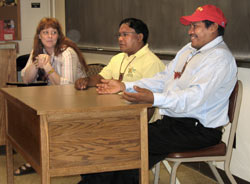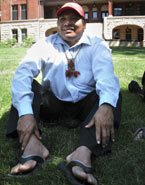Inside Iowa State
Inside ArchivesSubmit newsSend news for Inside to inside@iastate.edu, or call (515) 294-7065. See publication dates, deadlines. About InsideInside Iowa State, a newspaper for faculty and staff, is published by the Office of University Relations. |
June 8, 2006 Amazons in Amesby Erin Rosacker Lecturer Stephanie Alemán gives a whole new meaning to the phrase "taking your work home with you." Paul Chekema and Wachana Yaymochi left their Amazonian lands in southern Guyana and northern Brazil for the first time, traveling to Ames via New York City for their first trip to the United States. The Amerindian (South American native Indian) men are from the Waiwai tribal village of Masakinyarï ("Mosquito Place"), where Alemán has conducted four research trips since 1997. 
Chekema served as the elected village leader (kayaritomo) for many years, while Yaymochi is the head of the family that housed Alemán during her visits. The Waiwai (pronounced "why-why") are one of nine indigenous tribes in Guyana, and Masakinyarï, with about 200 residents, is the largest of the two Waiwai villages in the country. "They are a pretty isolated community," Alemán said. "I had an opportunity to set up a situation where two of them could come here and visit me, since I've spent so much time with them." Waiwais collaborate on art projectThe Waiwai tribe is participating in the North South Project, which supports collaboration of native art and modern production with an emphasis on the use of sustainable materials. Their weaving skills were used in a partnership with Jocelyn Dow, owner of the Guyanese furniture manufacturing company Liana Cane Interiors, and Canadian furniture designer Patty Johnson. Chekema and Yaymochi represented the Waiwai at the International Contemporary Furniture Fair (ICFF) in New York. "We fly on a big plane, big jet," Yaymochi described. "We thought we went to heaven." After four days at the ICFF (May 20-23), Alemán accompanied the pair to Ames, where they will stay with her family until June 12. Alemán, who came to ISU after earning her doctorate from the University of Wisconsin in 2005, will drive the men to Madison for a four-day visit before sending them home. Students in Alemán's Anthropology 201 course were able to meet and interview the two men. Both speak English, but Yaymochi is the most fluent. Although Guyana is the only English-speaking country in South America and school classes are taught in English, Waiwai is the primary language used in the village. The anthropology department and Conservation International helped with the funding for this leg of their trip, which features a venture to the Meskwaki Indian community near Tama. Chekema and Yaymochi look forward to hearing the language of North American native Indians and learning about their sustainable rural farming methods. Although they see some similarities between Iowa and their home (trees, sun, wind), it is the differences that fascinate them. "The buildings, the houses here," Yaymochi said. "Big buildings." Cars, which they don't have in the rain forest, and trains, which they don't have in Guyana, are eye-popping. They also consider the condition of the roads and the "polite" Iowa drivers superior to those in Georgetown, Guyana's capital. Accustomed to extended travel -- it takes a long time to get anywhere from the middle of the jungle -- the men are not yet homesick. However, they do miss their local food. Missing the cassava bread"Mostly we miss cassava bread and flour," Yaymochi said. It is an everyday part of their diet, made from the cassava root plant, which they raise on their family farm areas. The Waiwai also farm fruits (pineapple, bananas, plantains, watermelon, pumpkin), tricorn and sugar cane. Some of the activities left on the itinerary for Chekema and Yaymochi include a canoe trip on the river, a ride on the Boone and Scenic Valley Railroad and a trip to Madison's zoo. They hope to return home with a better understanding of English and how people keep up their living spaces, as well as bring tools and items of American quality. Alemán has done some follow-up on her research during the visit, getting updates from her last trip to Guyana in 2002. "Part of my research is to understand the impact of place on identity," she said. "Having the Waiwai here helps me to understand how they mediate a change of place in terms of their sense of self." It also has given her the chance to illustrate her own experiences that she shares in the classroom, as well as showcase her department's commitment to its growing cultural section. "It gives me the opportunity to use my own first-hand experience as a teaching tool," Alemán said. "It's important to have this link with the university and to present the university to the outside world that we are actively engaged in what it is we're teaching and learning about. It is real evidence of research." Alemán hopes to return to Guyana next summer with her two sons. Her three-year-old (Carmelo Wachana Alemán) and 18-month-old (Xavier Chekema Alemán) were named in honor of the Waiwai visitors and already know some of the language. Their first Waiwai word was "pura," which means "no." |

Paul Chekema 
Wachana Yaymochi photos by Erin Rosacker SummaryStephanie Alemán's Anthropology 201 students were able to meet and interview two Amazonian native men that are in Ames visiting the lecturer. Quote"It gives me the opportunity to use my own first-hand experience as a teaching tool." Stephanie Alemán, lecturer |